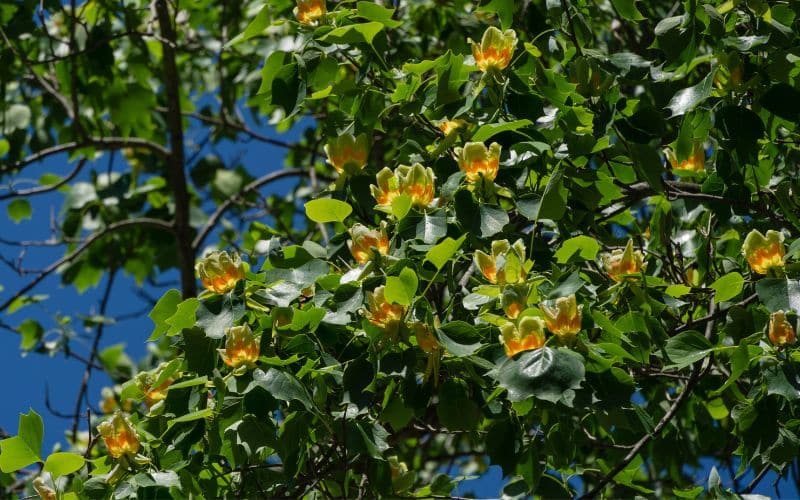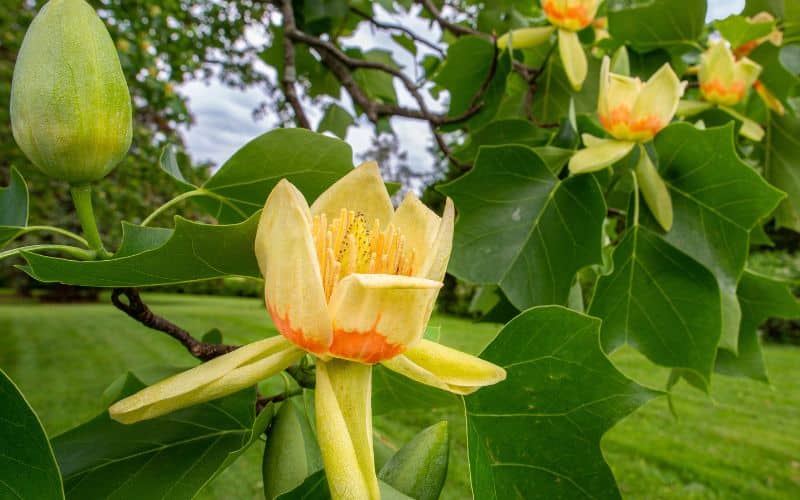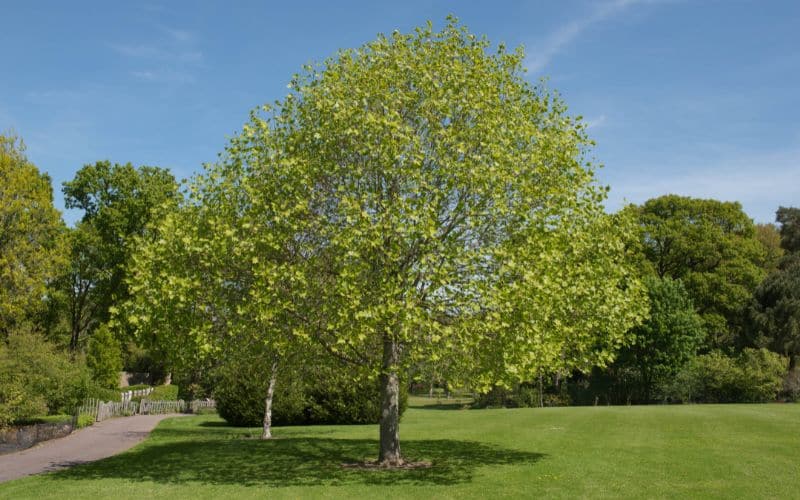
If you’re seeking a unique, eye-catching addition to your Ontario garden, look no further than the Tulip Tree. Despite its name, it’s not actually part of the tulip family. It’s a member of the Magnoliaceae family and is renowned for its stunning yellow-green blooms that resemble tulips.
Your eyes won’t be able to resist this tree’s allure come springtime when it bursts into bloom. Yet there’s more to this tree than just looks; it serves as an important source of food and shelter for wildlife too. As autumn approaches, you’ll marvel at how beautifully its leaves transition from vibrant green to golden yellow.
So why should you consider planting a Tulip Tree in your Ontario yard? Aside from enhancing your landscape aesthetically, they grow remarkably fast and live long lives — some have been known to survive for over 300 years! They’re resilient trees that can withstand our sometimes harsh Canadian winters without missing a beat.
Understanding the Tulip Tree
You’ve likely spotted the tulip tree, also known as Liriodendron tulipifera, across Ontario’s landscapes. But what exactly is this intriguing plant species? Let’s dive right in.
Renowned for its distinctive shape and bright green leaves, it gets its name from the unique flowers it produces. They’re not your typical floral display; instead they resemble a colourful blend of oranges and greens, much like a tulip! In fact, these flowers are so distinctive that they’ve been dubbed ‘tulips in the treetops’.
Ontario’s climate provides an ideal environment for these trees to thrive. Their love for well-drained soil combined with full sun or partial shade conditions makes them a common sight throughout our province.
Interestingly enough though, while you might think all trees are alike when it comes to growth speed – that’s where you’d be wrong. Tulip trees stand out by boasting one of the fastest rates of growth amongst their hardwood peers!
Here are some fascinating facts about how fast these beauties can grow:
| Year | Expected Height |
|---|---|
| 1 | 1-2m |
| 5 | Up to 4m |
| 10 | Over 6m |
Don’t mistake their speedy growth for fragility though! With proper care and attention (and Ontario’s favourable conditions), mature specimens have been known to reach incredible heights over time – often towering above other woodland giants at around 30 metres tall!
Of course we can’t forget about their environmental contributions either:
- They provide shelter and food sources for numerous bird species.
- Their dense foliage offers cool shade during those scorching summer months.
- The decomposition of fallen leaves enriches soil fertility boosting local biodiversity.

How to Identify a Tulip Tree in Ontario
Venturing into the lush landscapes of Ontario, you’re bound to come across a variety of tree species. One that stands out for its unique characteristics is the Tulip Tree. So, how do you identify this remarkable plant amidst all the greenery? Let’s delve into it.
First off, take note of the tree’s height. Standing tall at around 20-30 metres high on average and up to 50 metres at maximum growth, it’s one of North America’s tallest hardwood trees. This towering structure can be your first clue when trying to spot a tulip tree in an Ontarian forest.
Next up are the leaves – their peculiar shape gives them away instantly! Resembling tulips (hence the name), they have four lobes separated by notches and are usually about 10-15 cm long with flat bases and two ear-like tips at their broadest part. In springtime, these leaves adopt a bright green colour which turns golden-yellow as autumn approaches.
Take another look upwards; if it’s between May and June you might see flowers too! Unlike most other trees native to Ontario province whose flowers blend with foliage or go unnoticed altogether due to size or lack thereof, tulip tree blooms command attention due its vibrant colours – typically orange banding on yellow-green petals – resembling those found on actual tulips!
Lastly but equally important is checking out its bark as well as overall branch arrangement for identification purposes:
- Bark: When young it appears smooth with whitish-grey tint gradually becoming darker & furrowed over years
- Branch Arrangement: Often pyramidal when young but changes dramatically forming irregular oval crown upon maturity
Caring for Your Tulip Tree: Essential Tips
Tulip trees are a true marvel, aren’t they? Their vibrant colours and unique shapes make them stand out in any Ontario garden. Yet, you might be wondering how to properly care for this magnificent specimen. Don’t worry; we’ve got you covered with these essential tips.
Firstly, let’s talk about watering your tulip tree. It’s crucial to keep the soil consistently moist during the first few years of its life. But don’t drown it! Over-watering can lead to root rot and other problems that could potentially kill your tree.
- Regular watering: Once or twice a week
- Drought conditions: Three times a week
Soil is another important factor when caring for your tulip tree. These trees prefer well-drained soil that’s rich in organic matter. Adding compost or manure can enhance the nutrient content of your soil and promote healthier growth.
When it comes to pruning, timing is everything:
| Season | Pruning Advice |
|---|---|
| Spring | Avoid as sap flows heavily |
| Summer | Ideal time after leaves have fully developed |
Prune only when necessary such as removing dead branches or shaping young trees. Over-pruning may weaken the tree structure leading to potential breakage during storms.
Lastly, pest control should not be overlooked in maintaining a healthy tulip tree. Common pests like aphids and scales can often infest these trees causing damage if left unchecked.
You’ve now learned some key points on caring for your Tulip Tree – proper watering practices, suitable soil conditions, correct pruning timings and effective pest control measures will ensure its longevity! Remember though – every tree has its quirks so observing what works best specifically for yours is invaluable knowledge too!

Threats and Diseases Affecting the Tulip Trees in Ontario
The tulip tree, a staple of Ontario’s beautiful landscape, is unfortunately not immune to threats and diseases. Here’s what you need to know.
Firstly, let’s talk about environmental threats. Tulip trees require ample sunlight for growth and development. When they’re overshadowed by larger plants or buildings, their health can be compromised leading to stunted growth or death. Also bear in mind that these trees are sensitive to drought conditions which are becoming increasingly prevalent due to climate change.
Next on the list is insects – quite a menace! The yellow-poplar weevil (Odontopus calceatus) poses a significant threat with its insatiable appetite for tulip tree leaves during springtime causing extensive defoliation which hampers the tree’s photosynthesis process. Additionally, aphids can also cause harm as they suck sap from these precious greens leaving them weakened over time.
Diseases aren’t left out either when it comes down to threatening our beloved tulips’ well-being. Verticillium wilt caused by soil-borne fungi (Verticillium spp.) leads the pack here damaging roots resulting in wilting and browning of leaves while eventually killing branches or even whole trees if left unchecked! Other fungal infections like powdery mildew may leave unsightly white patches on leaves but thankfully don’t pose as grave a danger as Verticillium wilt does.
And then there are pests like deer who find young tulip saplings particularly appetising especially during winters when food sources become scarce – another challenge faced by our fragile beauties!
Conclusion: Embracing the Beauty of Tulip Trees
You’ve come a long way in your journey to understand the magnificence of Ontario’s tulip trees. It’s evident that these towering beauties offer more than just an aesthetic appeal. They’re vital components of our ecosystem, offering shelter and sustenance to various wildlife species.
You may have been surprised by how many benefits these trees provide. From their ability to enhance air quality, combat climate change and even boost property value – it’s clear why they hold such high regard within Ontario.
But let’s not forget about their most captivating feature – those enchanting tulip-shaped flowers that adorn them each spring! These floral displays are truly something special:
- Softly coloured petals creating a delightful contrast against the tree’s glossy green leaves
- The delicate fragrance wafting through your garden on warm spring days
- Their unique shape providing an artistic flair unmatched by any other tree in Ontario
The beauty you’ll experience with a tulip tree in your own backyard is simply unparalleled!
Don’t be daunted if you’re thinking about planting one yourself. Remember, patience pays off when it comes to growing tulip trees – but once established, they require minimal upkeep and offer countless rewards for years on end.
Now that you’re well-versed with everything there is to know about Tulip Trees in Ontario, we hope this has sparked some curiosity or perhaps inspired action towards nurturing nature’s wonders close home!
Whether it means adding one to your landscape or simply admiring them from afar during walks through local parks – every step counts towards appreciating and preserving our natural world.
So go ahead…embrace the beauty of Tulip Trees!








